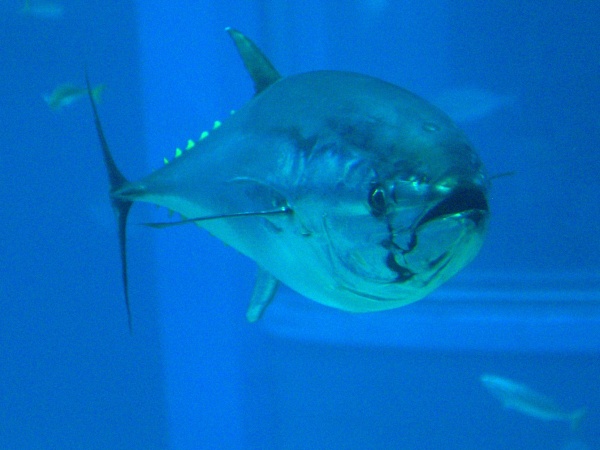
Today, a fish story.
Bluefin tuna are following the same trajectory as the passenger pigeon. Because they taste good they’re poised to go extinct.
Atlantic (Thunnus thynnus) and Pacific bluefin tuna (Thunnis orientalis) are highly migratory predators that spawn on one side of their respective oceans and travel thousands of miles on migration to their feeding grounds. When they reach maturity at three to five years old they return to spawn. Bluefins can live 15 to 50 years and reach up to 990 pounds but because of overfishing very few live to maturity.
Like the passenger pigeon, human hunting pressure is the only reason for the bluefin’s decline. Technological advances in deep sea fishing have made it easy to catch all of them. Their meat is so prized in Japan for sushi and sashimi that the Pacific population has declined more than 97%. Large specimens are so rare that according to the January 11, 2013 issue of TIME magazine, “Just last week, a 489-lb. bluefin was sold at a fish auction in Tokyo for a record $1.76 million—or about $3,600 per pound.” That was nearly four years ago. Their status has only gotten worse.
Like the final decades of the passenger pigeon, the bluefin’s plight has been discussed for years. Catch limits for Atlantic bluefin have been in place since 2007 and it’s been nominated for endangered status. In 2010 the World Wildlife Fund pointed out there was still so much over-capacity for Atlantic tuna fishing that EU boats reached their catch limit in only one week. In 2011 Salon magazine asked, “Why are we still eating bluefin tuna?” In 2014, the Center for Biodiversity called for a Pacific bluefin fishing ban.
This summer the situation became so dire that a dozen environmental groups called for listing the Pacific bluefin tuna as Endangered and the Pew Trusts called for a Pacific bluefin moratorium.
This Pew Trusts video explains how the Pacific moratorium, implemented immediately, would save the species.
We still have time to turn it around — but not much.
Will bluefin tuna go the way of the passenger pigeon … from billions to none?
(photo from Wikimedia Commons. Click on the image to see the original.)
Another great eye opener, thanks Kate! I responded yesterday mentioning the increased pressure on food production due to human overpopulation. Eating ‘down the food chain’ is a great way to help. International regulations to manage commercial fishing are greatly needed. Controlling what we eat in this country is an important step. Trying to get the growing middle class in Asian countries to curb their appetite for traditional foods (and ivory trinkets) is a more difficult task. Whaling that occurs in the name of science with no actual science being performed is another problem. Recently it has been shown that much of the seafood sold in this country is not actually the species you think it is, and sometimes the food vendors don’t know what species they have either. Consider supporting plans to make seafood traceable to its source so we have a better idea of what is being caught. Hopefully humans will realize that nature’s bounty is not limitless before it is too late….
Both of these fist posts make my heart ache. I will admit to being part of the problem. Going out for sushi in California is a real treat and we do indulge every couple of months. Most restaurants around here have stopped serving swordfish, thankfully, but we need to do something to save the bluefin tuna. I might have to be the change in my world and stop eating it all together. There are other choices on the menu. 🙂
Thanks for bringing light to these situations Kate. You made me pause and think.